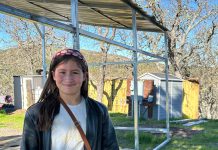A study released Monday revealed what local teachers and
administrators had known for some time: California schools spend
less money per student than almost all other states and have some
of the most crowded classrooms in the nation.
Hollister – A study released Monday revealed what local teachers and administrators had known for some time: California schools spend less money per student than almost all other states and have some of the most crowded classrooms in the nation.
The report, conducted by Rand Corp., found that class sizes in the state were the second biggest in the nation, with almost 21 students per teacher compared to the nationwide average of 16 students per teacher. The largest school districts in San Benito County had even higher ratios than the state average.
The state also spent approximately $600 less than the national average on students and ranked 47th in academic performance behind only Louisiana and Mississippi, according to the report. While states like New York and New Jersey spend an average of $11,000 per student, California spends slightly over $7,000. In San Benito County, the number is even smaller, with only Aromas-San Juan Unified and Cienega Union school districts coming close. San Benito High School District (SBHS) spends a little over $5,600 per child, while Hollister School District spends approximately $6,500, according to their School Accountability Report Cards.
The grim news confirms the challenges facing San Benito teachers who have been overburdened with more students this year, especially in kindergarten and fourth and fifth grade classrooms after state cuts to the education budget forced local school districts to increase the number of students in those classes.
“Kindergarten is where all the fundamentals start,” said Linda Smith, principal of R.O. Hardin School. “If you don’t give children that, you’re going to be playing catch for the rest of the years they are in school.”
Many kindergarten classes in the Hollister School District jumped from 20 students to over 30 this year and some fourth and fifth grade classes now have as many as 37 students in them. However, kindergarten classes with over 20 kids are required by law to have aides assisting the teachers, although many of them don’t have teaching credentials, a problem that was highlighted in the study.
To Dr. Jean Burns Slater, superintendent of SBHS, the news is troubling, but not surprising.
“What this says to me is that the same old stuff we have been doing is not working,” she said. “Our students are not progressing and we need to revamp what it is we are doing.”
Yet there seems to be little local districts can do because they rely overwhelmingly on the state for money for everything from supplies and materials to programs. Districts get money from local taxes as well as the federal government, but the bulk of their funding comes from Sacramento and depends on the decisions made at the legislative level.
“This is not the fault of the districts at all,” said Smith, R.O. Hardin’s principal. “It is what is being handed down from the state.”
California’s low performance is compounded by the state’s high English Learner population – one out of 10 people in the state is foreign born – and a high number of migrant families whose jobs require them to pull their kids out of school temporarily, according to the report. Both factors also contribute to the challenge of meeting the federally required academic standards such as No Child Left Behind, the report said.
Teachers already have a difficult time addressing all of their students’ needs and can’t give as much individualized attention as in the past, which has a direct correlation on student test scores, said local teachers.
“What bigger classrooms mean is that you can’t give students a lot of one-on-one attention,” said Geoffrey Holland, an eighth-grade history teacher at Rancho San Justo.
Many teachers are assigning less reports and written tests because grading the assignments is too time consuming, he said.
And if there are discipline problems in the already-crowded classroom, the situation quickly becomes chaotic.
“The state must change its priorities,” said Holland, adding that students need attention if they are expected to succeed in school. “We are not putting out peanut butter here.”
Karina Ioffee covers education for the Free Lance. Reach her at (831)637-5566 ext. 335 or ki*****@***********ws.com









